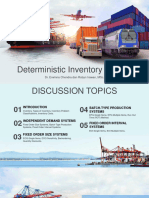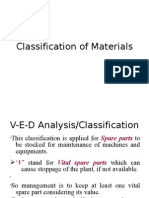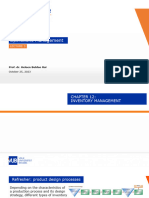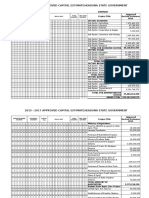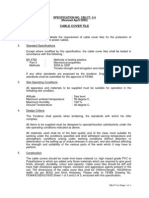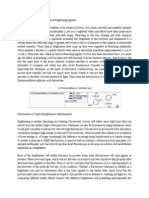Key Concepts: Week 5 Lesson 3: Economic Order Quantity (EOQ) Extensions
Uploaded by
Yusuf HusseinKey Concepts: Week 5 Lesson 3: Economic Order Quantity (EOQ) Extensions
Uploaded by
Yusuf HusseinKey Concepts: Week 5 Lesson 3:
Economic Order Quantity (EOQ) Extensions
Learning Objectives
Understand impact of a non-zero deterministic lead time on EOQ
Understand how to determine the EOQ with different volume discounting schemes
Understand how to determine the Economic Production Quantity (EPQ) when the inventory
becomes available at a certain rate of time instead of all at once.
Lesson Summary:
The
Economic
Order
Quantity
can
be
extended
to
cover
many
different
situations.
We
covered
three
extensions:
lead-time,
volume
discounts,
and
finite
replenishment
or
EPQ.
We
developed
the
EOQ
previously
assuming
the
rather
restrictive
(and
ridiculous)
assumption
that
lead-
time
was
zero.
That
is,
instantaneous
replenishment
like
on
Star
Trek.
However,
we
show
in
the
lesson
that
including
a
non-zero
lead
time,
while
increasing
the
total
cost
due
to
having
pipeline
inventory,
will
NOT
change
the
calculation
of
the
optimal
order
quantity,
Q*.
In
other
words,
lead-time
is
not
relevant
to
the
determination
of
the
needed
cycle
stock.
Volume
discounts
are
more
complicated.
Including
them
makes
the
purchasing
costs
relevant
since
they
now
impact
the
order
size.
We
discussed
three
types
of
discounts:
All-Units
(where
the
discount
applies
to
all
items
purchased
if
the
total
amount
exceeds
the
break
point
quantity),
Incremental
(where
the
discount
only
applies
to
the
quantity
purchased
that
exceeds
the
breakpoint
quantity),
and
One-Time
(where
a
one-time
only
discount
is
offered
and
you
need
to
determine
the
optimal
quantity
to
procure
as
an
advance
buy).
Discounts
are
exceptionally
common
in
practice
as
they
are
used
to
incentivize
buyers
to
purchase
more
or
to
order
in
convenient
quantities
(full
pallet,
full
truckload,
etc.).
Finite
Replenishment
is
very
similar
to
the
EOQ
model,
except
that
the
product
is
available
at
a
certain
production
rate
rather
than
all
at
once.
In
the
lesson
we
show
that
this
tends
to
reduce
the
average
inventory
on
hand
(since
some
of
each
order
is
manufactured
once
the
order
is
received)
and
therefore
increases
the
optimal
order
quantity.
Key Concepts:
Leadtime is greater than 0 (order not received instantaneously)
o Inventory Policy
CTL.SC1x Supply Chain & Logistics Fundamentals 1
o Order Q* units when IP=DL
o Order QI unties every T* time periods
Discounts
o All Units DiscountDiscount applies to all units purchased if total amount exceeds the break
point quantity
o Incremental DiscountDiscount applies only to the quantity purchased that exceeds the
break point quantity
o On Time Only DiscountA one time only discount applies to all units you order right now
(no quantity minimum or limit)
Finite Replenishment
o Inventory becomes available at a rate of P units/time rather than all at one time
o If Production rate approach infinity, model converges to EOQ
Notation:
c: Purchase cost ($/unit)
ci: Discounted purchase price for discount range i ($/unit)
e
c i: Effective purchase cost for discount range i ($/unit) [for incremental discounts]
ct: Ordering Costs ($/order)
ce: Excess holding Costs ($/unit/time); Equal to ch
cs: Shortage costs ($/unit)
cg: One Time Good Deal Purchase Price ($/unit)
Fi: Fixed Costs Associated with Units Ordered below Incremental Discount Breakpoint i
D: Demand (units/time)
DA: Actual Demand (units/time)
DF: Forecasted Demand (untis/time)
h: Carrying or holding cost ($/inventory $/time)
L: Order Leadtime
Q: Replenishment Order Quantity (units/order)
Q*: Optimal Order Quantity under EOQ (units/order)
Qi: Breakpoint for quantity discount for discount i (units per order)
Qg: One Time Good Deal Order Quantity
P: Production (units/time)
T: Order Cycle Time (time/order)
T*: Optimal Time between Replenishments (time/order)
N: Orders per Time or 1/T (order/time)
TRC(Q): Total Relevant Cost ($/time)
TC(Q): Total Cost ($/time)
CTL.SC1x Supply Chain & Logistics Fundamentals 2
Formulas:
Average Pipeline Inventory
The amount of inventory, on average, is the annual demand times the lead time. Essentially, every item
spends L time periods in transit.
Total Cost including Pipeline Inventory
The TC equation changes slightly if we assume a non-zero leadtime and include the pipeline inventory.
= + ! + ! + + ! [ ]
2
Note
that
as
before,
though,
the
purchase
cost,
shortage
costs,
and
now
pipeline
inventory
is
not
relevant
to
determining
the
optimal
order
quantity,
Q*:
2!
=
!
Discounts
If
we
include
volume
discounts,
than
the
purchasing
cost
becomes
relevant
to
our
decision
of
order
quantity.
All Units Discounts
The procedure for a single range All Units quantity discount (where new price is c1 if ordering at least Q1
units) is as follows:
1. Calculate
Q*C0
,
the
EOQ
using
the
base
(non-discounted)
price,
and
Q*C1
,
the
EOQ
using
the
first
discounted
price
2. If
Q*C1
Q1,
the
breakpoint
for
the
first
all
units
discount,
then
order
Q*C1
since
it
satisfies
the
condition
of
the
discount.
Otherwise,
go
to
step
3.
3. Compare
the
TRC(Q*C0),
the
total
relevant
cost
with
the
base
(non-discounted)
price,
with
TRC(Q1),
the
total
relevant
cost
using
the
discounted
price
(c1)
at
the
breakpoint
for
the
discount.
If
TRC(Q*C0)<
TRC(Q1),
select
Q*C0,
other
wise
order
Q1.
Note that if there are more discount levels, you need to check this for each one.
= ! 0 ! = ! !
= ! + ! + ! 0 !
2
CTL.SC1x Supply Chain & Logistics Fundamentals 3
= ! + ! + ! !
2
Incremental Discounts
The
procedure
for
a
multi-range
Incremental
quantity
discount
(where
if
ordering
at
least
Q1
units,
the
new
price
for
the
Q-Q1
units
is
new
price
is
c1)
is
as
follows:
1. Calculate the Fixed cost per breakpoint, Fi ,
2. Calculate the Q*i for each discount range i (to include the Fi)
3. Calculate the TRC for all discount ranges where the Qi-1 < Q*i < Qi+1 , that is, if it is in range.
4. Select the discount that provides the lowest TRC.
The effective cost, cei, can be used for the TRC calculations.
! = 0 ; ! = !!! + (!!! ! )!
2(! + ! )
=
!
!
!! = ! +
!
One Time Discount
This is a less common discount but it does happen. Simply calculate the Q*g and that is your order
quantity. If Q*g =Q* then the discount does not make sense. If you find that Q*g < Q*, you made a
mathematical mistake check your work!
! !
= + = 2! +
= !"
! ! ! !
= 2! + ! ! + ! + !
2
+ ( ! )
! =
!
CTL.SC1x Supply Chain & Logistics Fundamentals 4
Finite Replenishment or Economic Production Quantity
One can think of the EPQ equations as generalized forms where the EOQ is a special case where
P=infinity. As the production rate decreases, the optimal quantity to be ordered increases. However,
note that if P<D, this means the rate of production is slower than the rate of demand and that you will
never have enough inventory to satisfy demand.
! 1
= +
2
2!
= =
1 1
Additional References:
There
are
more
books
that
cover
the
basics
of
inventory
management
than
there
are
grains
of
sand
on
the
beach!
Inventory
management
is
also
usually
covered
in
Operations
Management
and
Industrial
Engineering
texts
as
well.
A
word
of
warning,
though.
Every
textbook
uses
different
notation
for
the
same
concepts.
Get
used
to
it.
Always
be
sure
to
understand
what
the
nomenclature
means
so
that
you
do
not
get
confused.
I
will
make
references
to
our
core
texts
we
are
using
in
this
course
but
will
add
some
additional
texts
as
they
fit
the
topics.
Inventory
is
introduced
in
Nahmias
Chpt
4
and
Silver,
Pyke
&
Peterson
Chpt
5,
and
Ballou
Chpt
9.
CTL.SC1x Supply Chain & Logistics Fundamentals 5
You might also like
- Roitt'S Essential Immunology 12Th Edition (All Mcqs With Answers)100% (9)Roitt'S Essential Immunology 12Th Edition (All Mcqs With Answers)100 pages
- Extensions To EOQ Model: CTL - SC1x - Supply Chain & Logistics FundamentalsNo ratings yetExtensions To EOQ Model: CTL - SC1x - Supply Chain & Logistics Fundamentals36 pages
- Key Concepts: Week 5 Lesson 2: Economic Order Quantity (EOQ)No ratings yetKey Concepts: Week 5 Lesson 2: Economic Order Quantity (EOQ)4 pages
- Chapter 11 Inventory Models 11.1 Basic Concepts in Inventory PlanningNo ratings yetChapter 11 Inventory Models 11.1 Basic Concepts in Inventory Planning24 pages
- Professor: Bob Carpenter: Business Decision Making ADMN2167No ratings yetProfessor: Bob Carpenter: Business Decision Making ADMN216739 pages
- Supply Chain Management. Inventory Management (Inglés) Autor Donglei DuNo ratings yetSupply Chain Management. Inventory Management (Inglés) Autor Donglei Du83 pages
- OMT 8604 Logistics in Supply Chain Management: Master of Business AdministrationNo ratings yetOMT 8604 Logistics in Supply Chain Management: Master of Business Administration42 pages
- Inventory Management: Chapter 13 (Stevenson)No ratings yetInventory Management: Chapter 13 (Stevenson)51 pages
- Inventory Management Session 1 - StudentNo ratings yetInventory Management Session 1 - Student58 pages
- Inventory Policy Decisions by Sinjana - VishalNo ratings yetInventory Policy Decisions by Sinjana - Vishal106 pages
- W2 - Inventory Management Part 1 (Pendek 2022 2023)No ratings yetW2 - Inventory Management Part 1 (Pendek 2022 2023)42 pages
- Inventory Management, Supply Contracts and Risk PoolingNo ratings yetInventory Management, Supply Contracts and Risk Pooling81 pages
- Managing Economies of Scale Cycle InventoryNo ratings yetManaging Economies of Scale Cycle Inventory33 pages
- Economic Order Quantity (EOQ) : CTL - SC1x - Supply Chain & Logistics FundamentalsNo ratings yetEconomic Order Quantity (EOQ) : CTL - SC1x - Supply Chain & Logistics Fundamentals31 pages
- Inventory Systems For Independent DemandNo ratings yetInventory Systems For Independent Demand4 pages
- Inventory Management & Model Theory: Bernard Price Certified Professional LogisticianNo ratings yetInventory Management & Model Theory: Bernard Price Certified Professional Logistician37 pages
- Inventory Management and Risk Pooling: Prepared byNo ratings yetInventory Management and Risk Pooling: Prepared by74 pages
- CISA EXAM-Testing Concept-Recovery Time Objective (RTO) & Recovery Point Objective (RPO)From EverandCISA EXAM-Testing Concept-Recovery Time Objective (RTO) & Recovery Point Objective (RPO)1/5 (2)
- Resource Usage: Issues Covered in This ChapterNo ratings yetResource Usage: Issues Covered in This Chapter21 pages
- Lec 1 - Introduction To Wireless CommunicationNo ratings yetLec 1 - Introduction To Wireless Communication60 pages
- RSH - Qam11 - Excel and Excel QM Explsm2010No ratings yetRSH - Qam11 - Excel and Excel QM Explsm2010153 pages
- Yaaqshiid: 1 Xaafadaha, Laamaha Iyo Waax-AhaNo ratings yetYaaqshiid: 1 Xaafadaha, Laamaha Iyo Waax-Aha4 pages
- Data and Process Modeling: Husein OsmanNo ratings yetData and Process Modeling: Husein Osman17 pages
- Sample Solution: Midterm Exam - 300 PointsNo ratings yetSample Solution: Midterm Exam - 300 Points4 pages
- Chapter Four: Entering Beginning BalancesNo ratings yetChapter Four: Entering Beginning Balances4 pages
- Solution of Assignment Eco-04 Case: Mike (The Plumber) - A True StoryNo ratings yetSolution of Assignment Eco-04 Case: Mike (The Plumber) - A True Story5 pages
- COB291, Section - or Time of Class - Home Work Decision AnalysisNo ratings yetCOB291, Section - or Time of Class - Home Work Decision Analysis8 pages
- X P (X) XP (X) (X - E (X) ) P (X) : To See The Formulas, Hold Down The CTRL Key and Press The ' (Grave Accent) KeyNo ratings yetX P (X) XP (X) (X - E (X) ) P (X) : To See The Formulas, Hold Down The CTRL Key and Press The ' (Grave Accent) Key7 pages
- Research Methods - STA630 Spring 2007 Assignment 05No ratings yetResearch Methods - STA630 Spring 2007 Assignment 052 pages
- Process Flow of New Implementation in SAP at OEM: Created by RUSHI SONINo ratings yetProcess Flow of New Implementation in SAP at OEM: Created by RUSHI SONI62 pages
- CHM-304 Experiment: Preparation of Phosphine Based Metal ComplexesNo ratings yetCHM-304 Experiment: Preparation of Phosphine Based Metal Complexes4 pages
- Class 11 Physics Notes Chapter 10 Thermal Properties of MatterNo ratings yetClass 11 Physics Notes Chapter 10 Thermal Properties of Matter62 pages
- Research Article: An Empirical Study of Machine Learning Algorithms For Stock Daily Trading StrategyNo ratings yetResearch Article: An Empirical Study of Machine Learning Algorithms For Stock Daily Trading Strategy31 pages
- Historical Development of Optical Brightening AgentsNo ratings yetHistorical Development of Optical Brightening Agents2 pages
- Web Dynpro ABAP - OTR Text Translation ToolNo ratings yetWeb Dynpro ABAP - OTR Text Translation Tool10 pages
- Automatic Transmission / Trans: PreparationNo ratings yetAutomatic Transmission / Trans: Preparation2 pages
- AC/DC LED Ballasts :: ROAL Living EnergyNo ratings yetAC/DC LED Ballasts :: ROAL Living Energy3 pages
- Organic Chemistry Assignment-1: Complex Question SETNo ratings yetOrganic Chemistry Assignment-1: Complex Question SET6 pages
- Vectors Tensors 16 Curvilinear CoordinatesNo ratings yetVectors Tensors 16 Curvilinear Coordinates25 pages
- Y5 Autumn Block 5 Wo3 Area of Rectangles 2019No ratings yetY5 Autumn Block 5 Wo3 Area of Rectangles 20192 pages
- Roitt'S Essential Immunology 12Th Edition (All Mcqs With Answers)Roitt'S Essential Immunology 12Th Edition (All Mcqs With Answers)
- Microeconomics: QuickStudy Laminated Reference GuideFrom EverandMicroeconomics: QuickStudy Laminated Reference Guide
- Extensions To EOQ Model: CTL - SC1x - Supply Chain & Logistics FundamentalsExtensions To EOQ Model: CTL - SC1x - Supply Chain & Logistics Fundamentals
- Key Concepts: Week 5 Lesson 2: Economic Order Quantity (EOQ)Key Concepts: Week 5 Lesson 2: Economic Order Quantity (EOQ)
- Chapter 11 Inventory Models 11.1 Basic Concepts in Inventory PlanningChapter 11 Inventory Models 11.1 Basic Concepts in Inventory Planning
- Professor: Bob Carpenter: Business Decision Making ADMN2167Professor: Bob Carpenter: Business Decision Making ADMN2167
- Supply Chain Management. Inventory Management (Inglés) Autor Donglei DuSupply Chain Management. Inventory Management (Inglés) Autor Donglei Du
- OMT 8604 Logistics in Supply Chain Management: Master of Business AdministrationOMT 8604 Logistics in Supply Chain Management: Master of Business Administration
- W2 - Inventory Management Part 1 (Pendek 2022 2023)W2 - Inventory Management Part 1 (Pendek 2022 2023)
- Inventory Management, Supply Contracts and Risk PoolingInventory Management, Supply Contracts and Risk Pooling
- Economic Order Quantity (EOQ) : CTL - SC1x - Supply Chain & Logistics FundamentalsEconomic Order Quantity (EOQ) : CTL - SC1x - Supply Chain & Logistics Fundamentals
- Inventory Management & Model Theory: Bernard Price Certified Professional LogisticianInventory Management & Model Theory: Bernard Price Certified Professional Logistician
- Inventory Management and Risk Pooling: Prepared byInventory Management and Risk Pooling: Prepared by
- CISA EXAM-Testing Concept-Recovery Time Objective (RTO) & Recovery Point Objective (RPO)From EverandCISA EXAM-Testing Concept-Recovery Time Objective (RTO) & Recovery Point Objective (RPO)
- Solution of Assignment Eco-04 Case: Mike (The Plumber) - A True StorySolution of Assignment Eco-04 Case: Mike (The Plumber) - A True Story
- COB291, Section - or Time of Class - Home Work Decision AnalysisCOB291, Section - or Time of Class - Home Work Decision Analysis
- X P (X) XP (X) (X - E (X) ) P (X) : To See The Formulas, Hold Down The CTRL Key and Press The ' (Grave Accent) KeyX P (X) XP (X) (X - E (X) ) P (X) : To See The Formulas, Hold Down The CTRL Key and Press The ' (Grave Accent) Key
- Research Methods - STA630 Spring 2007 Assignment 05Research Methods - STA630 Spring 2007 Assignment 05
- Process Flow of New Implementation in SAP at OEM: Created by RUSHI SONIProcess Flow of New Implementation in SAP at OEM: Created by RUSHI SONI
- CHM-304 Experiment: Preparation of Phosphine Based Metal ComplexesCHM-304 Experiment: Preparation of Phosphine Based Metal Complexes
- Class 11 Physics Notes Chapter 10 Thermal Properties of MatterClass 11 Physics Notes Chapter 10 Thermal Properties of Matter
- Research Article: An Empirical Study of Machine Learning Algorithms For Stock Daily Trading StrategyResearch Article: An Empirical Study of Machine Learning Algorithms For Stock Daily Trading Strategy
- Historical Development of Optical Brightening AgentsHistorical Development of Optical Brightening Agents
- Organic Chemistry Assignment-1: Complex Question SETOrganic Chemistry Assignment-1: Complex Question SET



















